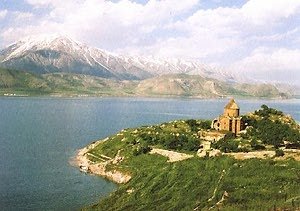 |
 |
|
The Turkish Van is an ancient breed from the Middle East, kept as domestic pets for hundreds of years. They originated in the Lake Van region of Turkey. Lake Van is the biggest lake in Turkey and has several islands, the largest of which called Ahtamar has the remains of the early Christian Church of the Holy Cross built in 910. The lake is a ‘soda lake’, so any fish are only at great depths and near estuaries. It has always been believed that cats first rose to prominence in Egypt, but having uncovered new evidence, opinions are being revised. An expedition conducted by the British Archaeological Institute in Ankara of a late Neolithic site (7000 years ago) near Hacilar has unearthed several small figures of a woman with cats. The first record of white, semi-long haired cats with ringed tails and colour on their heads were carvings on jewellery by the Hittites (1600-1200 BC). The Urarts who first settled in the City of Van also carved ringtail cats on ornaments. Archaeological finds from an ancient battle during the occupation of Armenia by the Romans around AD 75 include a battle standard bearing the image of a cat which was semi long haired and with a distinctive ringed tail. The history of the Van cat in the United Kingdom began in 1954 when Miss Laura Lushington, a journalist, and Miss Sonia Halliday, a photographer, were travelling around Turkey working for the Turkish Tourist Board. They were offered two unrelated kittens by their Turkish hosts, a female from south-eastern Turkey and a male from Istanbul. Both kittens were White with Auburn head markings and coloured tail, and amber eyes. The kittens accompanied them for the rest of their visit, and it was during this trip that both kittens strolled into a stream by which they were camped, and swam out of their depth apparently enjoying themselves. The kittens went through quarantine in England and later the female produced three kittens with near identical head and tail markings. For four years, the pair of cats continued to breed true, and on the advice of Mrs Grace Pond and Miss Kathleen Yorke, Miss Lushington decided to get the breed recognised in the UK. In 1959 she and Miss Halliday returned to Turkey where they also visited the city of Van as they wished to see the cats in their original and traditional area of Turkey. They brought back another pair of cats and then began the long process of obtaining recognition for the Turkish cats. Prof Dr Emin Ariturk, the then acting head of the Department of Animal Sciences at the University of Ankara, confirmed that the cats were a recognised breed, having been bred domestically in Turkey for many years. The cats gradually acquired the number of generations of breeding required and sufficient numbers to attain Championship status, which was achieved in 1969. |
 Home
Home  The TVCC
The TVCC About Us
About Us Committee
Committee Membership
Membership VanCatChat
VanCatChat Stud List
Stud List Turkish Cats
Turkish Cats Breed Description
Breed Description Characteristics
Characteristics Folklore
Folklore Standards
Standards Kittens
Kittens  Breeders
Breeders Kittens Available
Kittens Available News
News  Forthcoming Events
Forthcoming Events Show News
Show News 2012 AGM
2012 AGM Welfare
Welfare  Gallery
Gallery  More >
More >  Downloads
Downloads Guestbook
Guestbook Links
Links
 The present day city of Van stands to the east of the ruins of the ancient
city of Tushpa. It is also only a few miles from Mount Ararat and many
believe that after the Ark came to rest on the top of the mountain and
the flood waters receded that the cats left the Ark and made their way
down the mountain slopes into Van. It is also recounted that Allah blessed
all the animals as they were leaving the Ark, and the spot on their shoulders
is reputed to be where he accidentally touched the cats.
The present day city of Van stands to the east of the ruins of the ancient
city of Tushpa. It is also only a few miles from Mount Ararat and many
believe that after the Ark came to rest on the top of the mountain and
the flood waters receded that the cats left the Ark and made their way
down the mountain slopes into Van. It is also recounted that Allah blessed
all the animals as they were leaving the Ark, and the spot on their shoulders
is reputed to be where he accidentally touched the cats.